

Updated June 26, 2025
When people use virtual assistants such as Amazon Echo, they're relying on artificial intelligence (AI) to accomplish tasks such as playing music or checking the weather through voice commands. As virtual assistants grow in popularity, businesses should optimize their website content for voice search.
“Alexa, what is artificial intelligence?”
“Me,” Alexa likely would answer, according to our survey findings on consumer use of artificial intelligence (AI).
Looking for a Software Development agency?
Compare our list of top Software Development companies near you
Clutch surveyed 503 people about the connected devices they own and use. We found that approximately one-fourth of people who own a connected device own a standalone, automated virtual assistant such as an Amazon Echo or Google Home (27%).
Virtual assistants are powered by AI technology and respond to user requests and voice commands on devices such as smart speakers.
We found that people mostly use their virtual assistant to access information and issue simple commands such as setting alarms and checking the weather.
Businesses can use this data to understand how people currently use virtual assistants and adjust their search marketing to adapt to voice search commands.
People own and use other connected devices such as smart home appliances and wearables more than virtual assistants.
More than one-fourth of people with a connected device own a virtual assistant.

Just 16% use a virtual assistant the most compared to smart home appliances (49%) and wearables (23%).
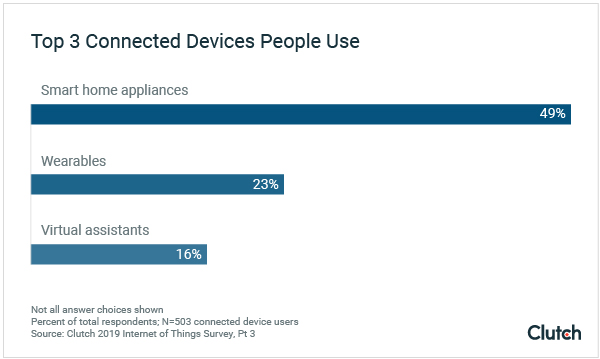
The number of people who own virtual assistant devices, though, is growing.
“Technology trends come and go, but we think voice is here to stay,” said Colin Morris, director of product management for Adobe Analytics, in a study published in 2018.
Devices equipped with voice search and command functions are increasingly entering people’s homes, according to industry research.
Smart speakers are the fastest growing tech device since the advent of smartphones, according to eMarketer. Now, approximately one-fourth of U.S. households have a smart speaker.
Amazon outranks Google as the most popular virtual assistant brand.
Two-thirds of people (66%) with a standalone virtual assistant own an Amazon Echo, which operates using Amazon’s AI-powered virtual assistant, Alexa. Forty percent (40%) own a Google Home device.
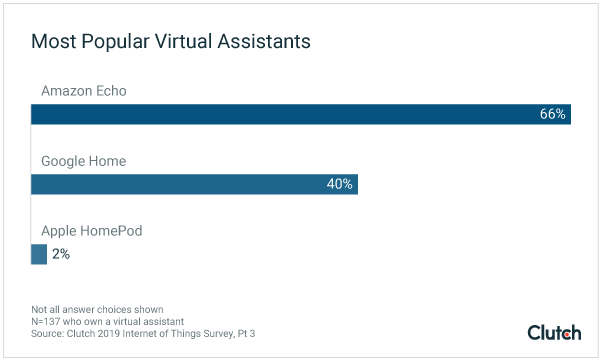
Recently, the growth of Google and Apple in the virtual assistant market has cut into Amazon’s market domination.
Google, in particular, has its virtual assistant embedded in over a billion devices because other virtual assistant manufacturers use its Android operating system.
“As the virtual assistant market grows, it will be largely at Amazon’s expense, from a market share perspective,” said Kent Lewis, president of Anvil Media, a digital marketing and SEO company in Portland, Ore. “That said, the pie continues to grow, so Amazon will still come out just fine.”
As virtual assistants enter more homes, there will be heightened competition among large tech firms and developers, though no one firm will dominate.
People primarily use virtual assistants for simple, informational queries or commands.
Two-thirds (66%) use them to play music or listen to podcasts, and 56% use them to set alarms or reminders.
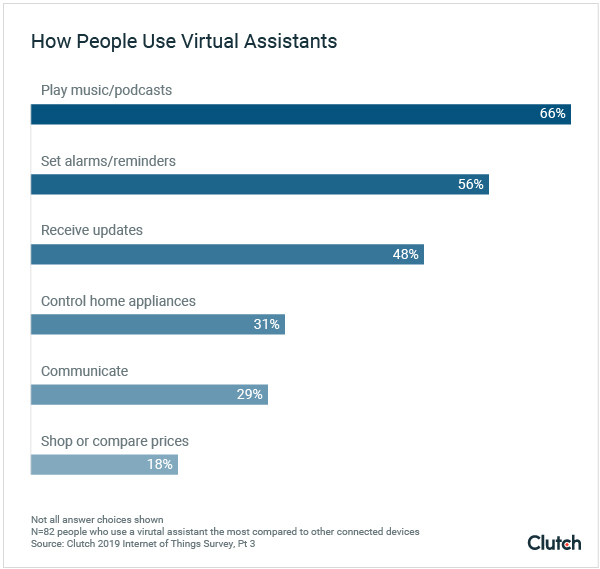
Nearly half of people (48%) use a virtual assistant to receive updates about news, weather, or sports.
The primary uses for virtual assistant devices depend on voice commands – particularly to set alarms and reminders and receive updates.
People’s comfort with voice commands will shift how businesses engage with people online, especially through search.
When people issue a voice command to their virtual assistant, it conducts a search query to find the best response.
When people ask a question using natural language, they expect their virtual assistant to understand their context.
“The biggest challenge is people would expect this kind of device to understand natural language and the context,” said Max Gladysh, co-founder of Botscrew, an AI development company in Lviv, Ukraine. “Consumers have much higher expectations when it comes to understanding the context.”
For example, if you ask a virtual assistant, “How much should my hiking backpack weigh?” the goal should be to learn the average weight of hiking backpacks – not the exact weight you, personally, should carry.
This nuance is apparent in natural human conversation but may not be apparent to a search engine.
This shift in search behavior puts the onus on businesses to adjust their content marketing and SEO strategies.
Specifically, your company should optimize its content for user intent. This means your content needs to respond directly to the conversational context people have when they ask their virtual assistant a question.
"[Voice search] means businesses need to target long-tail keywords and write conversational content," said Vitalii Yuryev, head of research and development at ELEKS, an enterprise software development company in Ukraine.
As the natural language processing and machine learning technology embedded in virtual assistants improve, the more comfortable people will be using their devices for complex tasks.
"Once users better understand how powerful context can be, they’ll be more comfortable asking more complicated questions," said Amanda Stevens, key account manager for Master of Code, a conversational AI development company. "Consumers need to be guided with a little bit of hand-holding."
As people use their virtual assistants for more complex voice searches, it will be more important for businesses to optimize their website content for voice search.
The answers virtual assistants provide to users’ voice commands and questions depend on the device they own and the nature of their search.
For example, the results you receive from asking Alexa about “jogging pants” will likely be from Amazon's own e-commerce listings.
Asking Google Home or an Apple HomePod, on the other hand, will result in the audio version of the top results that appear for the corresponding Google search.
For example, a voice search for “jogging pants” using Siri results in the following results.
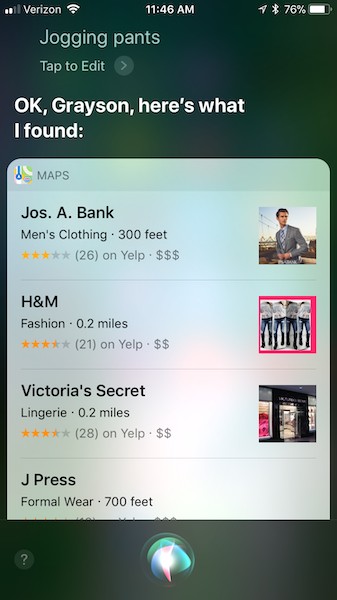
People should keep this context in mind when using a virtual assistant: Information shared may vary by brand of AI-powered device.
People value the information their virtual assistants provide, which indicates that they own virtual assistants to make some tasks easier. This core benefit of virtual assistants is in contrast to using virtual assistants as part of a connected network of smart devices.
Forty-four percent (44%) of people say access to important information is the primary benefit of using a virtual assistant.

The benefits people experience when using virtual assistants represent a first step toward trusting virtual assistants for more complex tasks.
“It starts with completing small tasks,” Gladysh said. “It will definitely become much bigger. In the next 5 to 10 years, I think people will do much more day-to-day tasks with their voice.”
As of now, only one-fourth of people claim connecting and controlling devices (26%) is the main benefit of using a virtual assistant.

When people expand the tasks they use virtual assistants to accomplish, the benefits they experience will shift from simply accessing information to controlling their home or other devices.
When people use their virtual assistants for simple requests and queries, they are less likely to experience challenges.
Connecting to networks (20%) is the problem that people experience the most with their virtual assistants. Over one-third of people (35%), however, experience no challenges.

For people who use their virtual assistants for more complex tasks, more challenges arise.
For example, only 25% of those who communicate with others using their virtual assistants experience no challenges with their devices.
Because people use their virtual assistants for simple tasks, they avoid challenges with the technology but sacrifice the ability to accomplish complex tasks.
By connecting a virtual assistant to other smart devices, people can expand what they control through voice commands.
People primarily connect their virtual assistants to their smartphones only (77%).
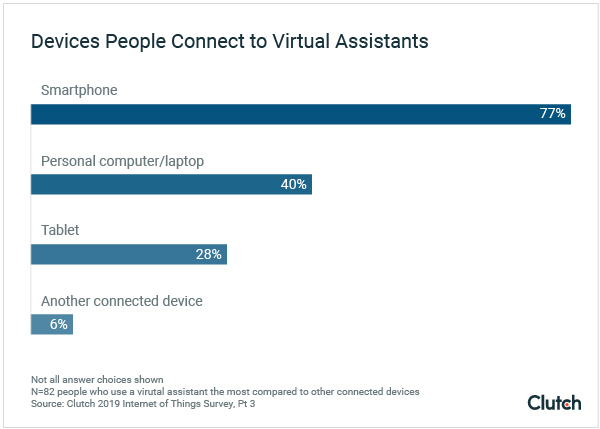
Less than half of people connect their virtual assistant to another device at all, and only 6% of people connect their virtual assistants to another connected device.
Taking the next step and connecting a virtual assistant to a smartwatch or smart home appliance, however, guarantees more use cases for virtual assistants.
The simpler it is to connect virtual assistants to other devices, the more people will use them to control other devices.
Three factors influence whether people connect other devices to their virtual assistants, said Mark Westlake, founder and editor of GearBrain, a consumer-facing device and recommendations website for IoT technologies.
“Education is key,” Westlake said. “The second thing is going to be getting the cost in-line and making it really simple for them [to connect].”
One reason why Amazon and Google have successful virtual assistants is because they make them compatible with other devices, according to Westlake.
Apple, too, developed Apple HomeKit, which acts as a “hub” for connecting devices, allowing people to simply scan a barcode to integrate a device with other devices.
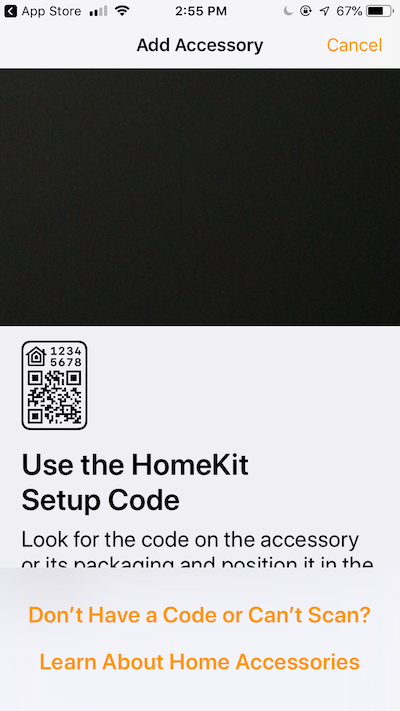
“With Apple Home Kit, the app is already on all the iPhones,” Westlake said. “If it’s compatible with Apple Home Kit, all you have to do is take a picture of the code on the side of the product, and it’s done. It’s connected.”
As people buy more devices from Amazon, Google, and Apple, they’ll be able to connect more devices and grow the number of tasks they can complete using voice commands.
Ultimately, the brands that master natural language processing will be the primary player in the market.
"Natural language processing is the future. Whoever excels building robust NLP engines for their bots will be the primary player in the market," Stevens said. "The ability to communicate with an AI-powered machine easily and simply will encourage further use – voice assistants are about solving problems with convenience."
Whichever brand can process voice commands and connect to other devices will win more users and earn long-term success.
Virtual assistants such as Amazon Echo or Google Home aren’t the most common connected devices that people own and use but are growing in popularity.
Currently, Amazon leads Google as the primary player in the consumer AI space, but their market share is declining with the growth of Google and Apple devices.
Most people use virtual assistants to accomplish simple tasks such as playing music or setting alarms. This shows that people are more comfortable using voice commands to access information.
With virtual assistants, people use more organic language for voice commands than for typed search queries on a desktop or a mobile device. As a result, companies need to optimize their content for users’ voice search intent.
The information that virtual assistants provide partially depend on brand. For example, Amazon Echo replies to commercial queries with product listings from Amazon.
People tend to use virtual assistants to gather information – a use case that lacks complexity and leads to claims of “no challenges” with virtual assistants.
Despite this, experts anticipate people will increase the number of devices they connect to virtual assistants as they become more comfortable with the technology. Connecting virtual assistants to other devices will, in turn, increase the complexity of tasks people can accomplish.
Clutch surveyed 503 people about the connected devices they own and use the most. Twenty-seven percent (27%) own a stand-alone, automated virtual assistant.
Over half (54%) of virtual assistant owners are male and 46% are female.
Virtual assistant owners skew younger in age: 44% are 13-34 years old; 29% are 35-54; 26% are 55 and older.


